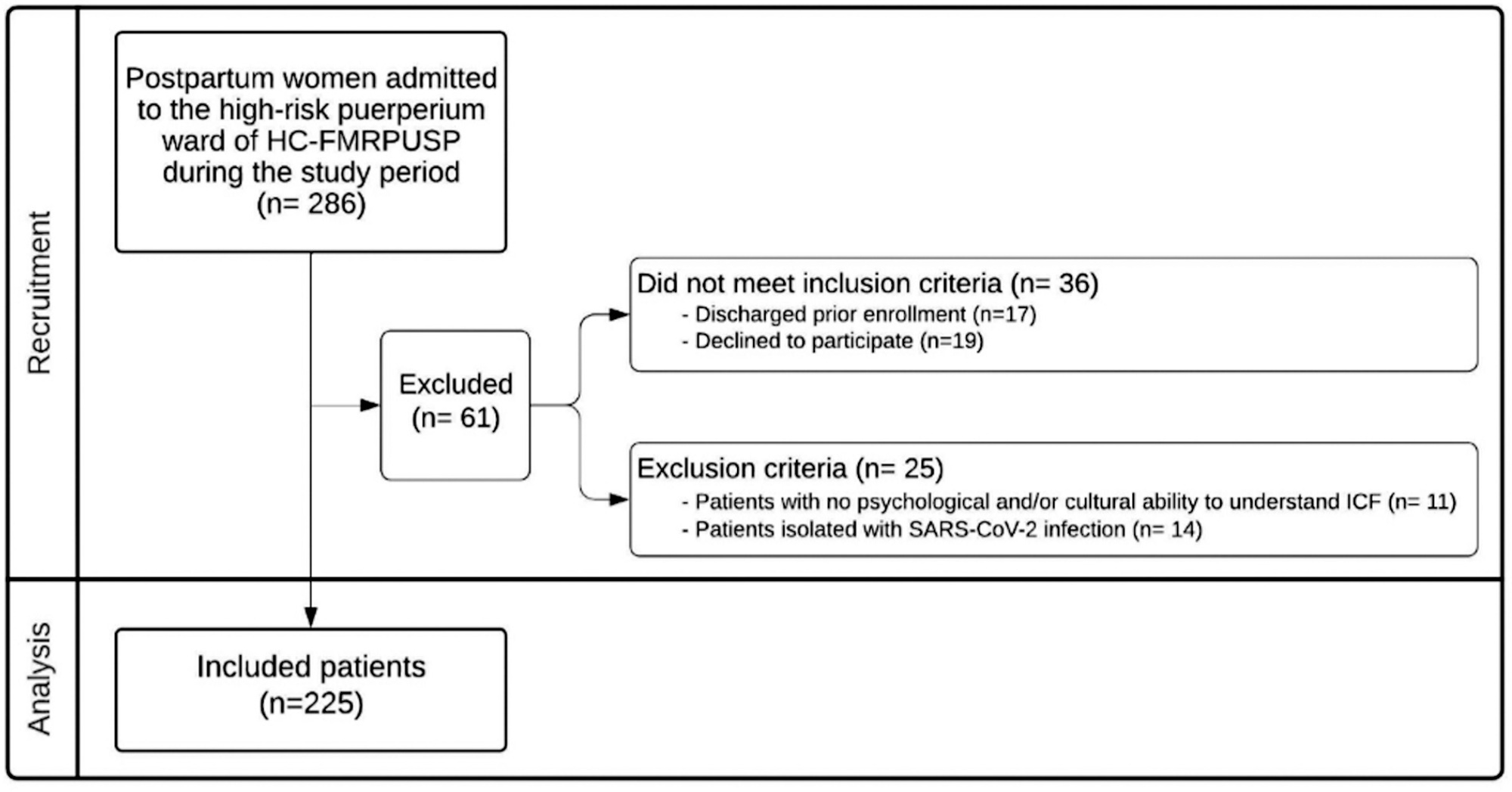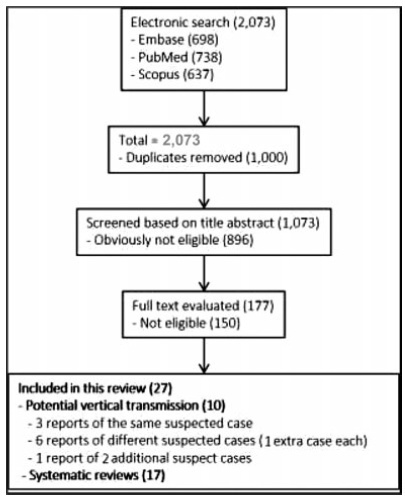Summary
Revista Brasileira de Ginecologia e Obstetrícia. 2023;45(2):059-064
To evaluate the seroprevalence of toxoplasmosis among puerperal women cared for at a tertiary university hospital and the level of understanding of these puerperal women about toxoplasmosis, vertical transmission, and its prophylaxis.
For this cross-sectional study, we evaluated 225 patients using presential interviews, prenatal documentation, and electronic medical records. Data were stored using Research Electronic Data Capture (REDCap) software. Prevalence rates were estimated by the presence of reactive IgG antibodies against Toxoplasma gondii. Data analysis was performed using the chi-square test and calculation of the odds ratio (OR). Seroreactivity to T. gondii and exposure variables (age, educational level, and parity) were analyzed using a confidence interval (95%CI) and a significance level of 5% (p < 0.05).
The seropositivity rate for T. gondii was 40%. There was no association between seroprevalence and age. Primiparity was a protective factor against seropositivity and low education was a risk factor.
Knowledge of T. gondii infection and its transmission forms was significantly limited, presenting a risk for acute maternal toxoplasmosis and vertical transmission of this protozoan. Increasing the education level regarding the risk of toxoplasmosis during pregnancy could reduce the rates of infection and vertical transmission of this parasite.

Summary
Revista Brasileira de Ginecologia e Obstetrícia. 2021;43(3):207-215
The evaluation of the available evidence on vertical transmission by severe acute respiratory syndrome coronavirus 2 (SARS-CoV)-2.
An electronic search was performed on June 13, 2020 on the Embase, PubMed and Scopus databases using the following search terms: (Coronavirus OR COVID-19 OR COVID19 OR SARS-CoV-2 OR SARS-CoV2 OR SARSCoV2) AND (vertical OR pregnancy OR fetal).
The electronic search resulted in a total of 2,073 records. Titles and abstracts were reviewed by two authors (WPM, IDESB), who checked for duplicates using the pre-established criteria for screening (studies published in English without limitation regarding the date or the status of the publication).
Data extraction was performed in a standardized way, and the final eligibility was assessed by reading the full text of the articles. We retrieved data regarding the delivery of the potential cases of vertical transmission, as well as themain findings and conclusions of systematic reviews.
The 2,073 records were reviewed; 1,000 duplicates and 896 clearly not eligible records were excluded. We evaluated the full text of 177 records, and identified only 9 suspected cases of possible vertical transmission. The only case with sufficient evidence of vertical transmission was reported in France.
The risk of vertical transmission by SARS-CoV-2 is probably very low. Despite several thousands of affected pregnant women, we have identified only one case that has fulfilled sufficient criteria to be confirmed as a case of vertical transmission. Well-designed observational studies evaluating large samples are still necessary to determine the risk of vertical transmission depending on the gestational age at infection.

Summary
Revista Brasileira de Ginecologia e Obstetrícia. 2020;42(1):5-11
Estimate the prevalence of human herpesvirus type 1 HSV-1 DNA in placental samples, its incidence in umbilical cord blood of newborns and the associated risk factors.
Placental biopsies and umbilical cord blood were analyzed, totaling 480 samples, from asymptomatic parturients and their newborns at a University Hospital. Nested polymerase chain reaction (PCR) and gene sequencingwere used to identify the virus; odds ratio (OR) and relative risk (RR) were performed to compare risk factors associated with this condition.
The prevalence of HSV-1 DNA in placental samples was 37.5%, and the incidence in cord blood was 27.5%. Hematogenous transplacental route was identified in 61.4% from HSV-1+ samples of umbilical cord blood paired with the placental tissue. No evidence of the virus was observed in the remaining 38.6% of placental tissues, suggesting an ascendant infection from the genital tract, without replication in the placental tissue, resulting in intra-amniotic infection and vertical transmission, seen by the virus in the cord blood. The lack of condom use increased the risk of finding HSV-1 in the placenta and umbilical cord blood.
The occurrence of HSV-1 DNA in the placenta and in cord blood found suggests vertical transmission from asymptomatic pregnant women to the fetus.
Summary
Revista Brasileira de Ginecologia e Obstetrícia. 2005;27(2):92-97
DOI 10.1590/S0100-72032005000200009
Visceral leishmaniasis (VL) is an endemic disease in the state of Mato Grosso do Sul, Brazil, mainly in the areas near the Paraguay and Paraná rivers. An increasing number of cases have been occurring especially in the state capital Campo Grande, with consequent occurrence of VL cases in pregnant women. This situation causes an elevated risk of vertical transmission of the parasite. In this report, we describe a case of VL in a pregnant woman followed up by our group, who was treated with liposomal amphotericin B, with no vertical transmission of the parasite. In our report, we demonstrate a therapeutic option for kala-azar during pregnancy, since antimoniate, the first-choice drug, is not prescribed during the gestational period.
Summary
Revista Brasileira de Ginecologia e Obstetrícia. 2005;27(1):32-36
DOI 10.1590/S0100-72032005000100007
PURPOSE: to evaluate the prevalence of HIV infection in parturient women from maternity hospitals linked to the Public Health Service in Sergipe state (Brazil) using the rapid test, and to evaluate this strategy to introduce the protocol for adequate management of HIV patients. METHODS: cross-sectional study which included the training of all health personnel and enrollment of every parturient woman admitted to maternity hospitals linked to the Public Health Service of Sergipe in the Northeast of Brazil. They received instructions about HIV perinatal transmission, were asked to undertake the rapid test, independently of their knowledge about their HIV serologic status, and signed the term of free consent. Additional information about antenatal care and obstetric history was obtained. The test used was the DetermineTM - Abbott Laboratories, and we used the Health Ministry protocol for HIV infeccion prophylaxis. A database was created at Epi-Info 2002, and the prevalence was calculated in relation to all tests performed from January 2003 to March 2004. RESULTS: after 9215 performed tests, 39 HIV-seropositive patients (0.42%) were detected. Twenty-three of them (59%) had no previous knowledge about their seropositivity. Two patients that already knew their positive sorology status did not refer this condition to the health persomel. The Health Ministry protocol was used for all positive cases. Antenatal care attendance was high (89%) but only 32.5% of the patients had already been submitted to an HIV serologic test during pregnancy. CONCLUSIONS: HIV prevalence in pregnant women (0.42%) in Sergipe was similar to the average rate in Brazil. A large number of seropositive pregnant women did not know their serologic status at the moment of delivery. This indicates bad antenatal care performance and the necessity to keep using HIV rapid test at the moment of labor and delivery in order to reduce vertical transmission.
Summary
Revista Brasileira de Ginecologia e Obstetrícia. 2004;26(4):325-328
DOI 10.1590/S0100-72032004000400010
OBJECTIVE: to evaluate the sensitivity and specificity of a rapid antibody HIV test (DetermineTM - Abott) for women in labor between August 1, 2001, and October 5, 2002. METHODS: all parturient women who had not been tested for the detection of HIV during pregnancy or had the result of an HIV test not available at admission were included in the present study. Blood samples were collected at the moment of admission, and the rapid test was carried out and compared with the gold standard (ELISA and Western blot). RESULTS: in 298 pregnant women assessed, the rapid test was positive in 16 (5.3%), and the results were confirmed by ELISA and Western blot in 12 cases (4%). All negative results were confirmed by the ELISA and Western blot tests. CONCLUSIONS: the test presented 100% sensitivity, 98% specificity, 75% positive predictive value, and 100% negative predictive value. These data show the importance of the rapid test for the detection of HIV infection in emergencies, such as imminent delivery of non-previously tested pregnant women.
Summary
Revista Brasileira de Ginecologia e Obstetrícia. 2004;26(2):131-138
DOI 10.1590/S0100-72032004000200008
PURPOSE: to analyze the management for reduction of HIV transmission from mother to infant in infected pregnant women who delivered in public maternity hospitals of the municipality of Fortaleza, Ceará, from 1999 to 2001. METHODS: a descriptive study where data of SINASC, SINAN and LACEN data bank systems were cross-checked looking for HIV-infected pregnant women, followed by an active search for complementary information on the subject through medical records of the maternity hospitals. RESULTS: a hundred and thirty-eight pregnant women infected with HIV were identified. It was observed that 35.5% knew their serum status before pregnancy and 48.6% (67/138) were diagnosed during the prenatal visits. Of those 101 women that knew their serum status before or during pregnancy, only 47.5% followed all steps of prophylaxis, including the management of the newborns. The previous knowledge of the serum status was found to be significantly related to following the correct steps of prophylaxis (p<0.001). CONCLUSIONS: an increasing number of women who had no access to the different strategies for the reduction of vertical transmission were found in Fortaleza, Ceará, especially among those who became pregnant without knowing their serum status. Continuous awareness and training are very important for all health care providers involved in attending the pregnant women for the application of correct management in order to reduce HIV transmission from mother to infant.

Summary
Revista Brasileira de Ginecologia e Obstetrícia. 2003;25(8):571-576
DOI 10.1590/S0100-72032003000800005
PURPOSE: to estimate the prevalence of the hepatitis B surface antigen (HBsAg) in parturients admitted to the "Instituto Materno-Infantil de Pernambuco (IMIP)", Recife-PE, and to determine the serologic profile of the positive ones. METHODS: this is a prospective cross-sectional study where the VIDAS and VIDAS HBs systems were used for detection and confirmation of HBsAg, respectively. The parturients were randomly selected. In HBsAg+ patients, the other serologic markers were tested by the use of the AxSYM automated system. The newborn babies of HBsAg+ mothers were vaccinated with the Engerix B vaccine. RESULTS: among 1584 parturients, there were 9 (0.6%) HBsAg positive. None of them had anti-HBc IgM, thus they were all prevalent cases. In 1/9 (11.1%) of the HBsAg+ mothers, HBeAg was isolated and in 4/9 (44.4%), this antigen circulated along with its antibody, hence the importance of establishing the different magnitudes of risk of vertical transmission. Except for two newborn babies from a twin pregnancy (one with low birth weight), all presented seroconversion to anti-HBs with 3 doses of the vaccine. The premature twin babies showed seroconvertion only after the fourth dose of the vaccine. CONCLUSIONS: the prevalence of hepatitis B among parturients at IMIP is relatively low and all patients diagnosed had the chronic form of the infection.